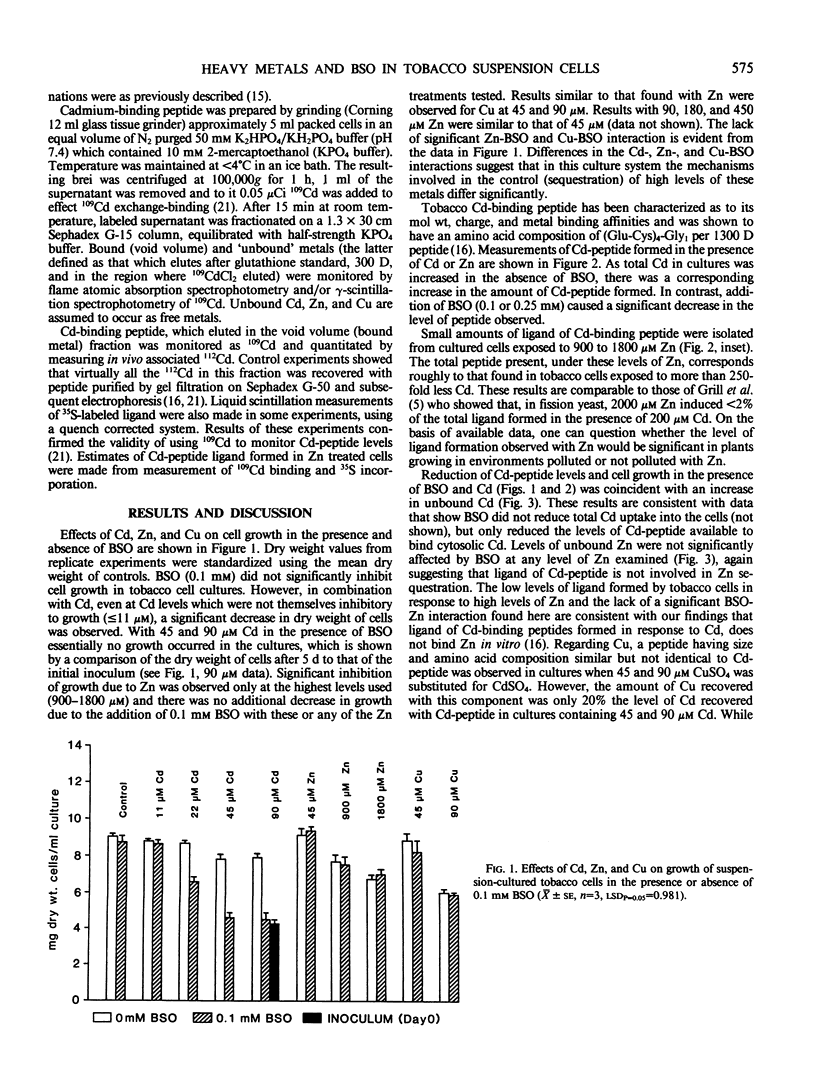Abstract
Inhibition of cell growth and accumulation of Cd-binding peptide were measured in cultured tobacco cells exposed to buthionine sulfoximine. This inhibitor of glutathione metabolism caused little or no reduction of growth (at 0.1 millimolar) in the absence of Cd, but growth was greatly reduced in cultures exposed to buthionine sulfoximine and ≥22 micromolar Cd. Decreased cell growth was directly correlated with decreased levels of Cd-binding peptide and increased levels of what is thought to be free Cd. Zinc inhibited growth of tobacco cells only at the highest levels examined (900-1800 micromolar Zn), but buthionine sulfoximine had no additional significant effect. Similar results were observed for Cu (45-90 micromolar). Results suggest that synthesis of plant Cd-peptide involves γ-glutamylcysteine synthetase or a related enzyme and that Zn accumulation in tobacco cells does not cause formation of significant Cd-peptide ligand.
Full text
PDF



Selected References
These references are in PubMed. This may not be the complete list of references from this article.
- Bartolf M., Brennan E., Price C. A. Partial Characterization of a Cadmium-binding Protein from the Roots of Cadmium-treated Tomato. Plant Physiol. 1980 Sep;66(3):438–441. doi: 10.1104/pp.66.3.438. [DOI] [PMC free article] [PubMed] [Google Scholar]
- Earnshaw B. A., Johnson M. A. The effect of glutathione on development in wild carrot suspension cultures. Biochem Biophys Res Commun. 1985 Dec 31;133(3):988–993. doi: 10.1016/0006-291x(85)91233-1. [DOI] [PubMed] [Google Scholar]
- Griffith O. W., Meister A. Potent and specific inhibition of glutathione synthesis by buthionine sulfoximine (S-n-butyl homocysteine sulfoximine). J Biol Chem. 1979 Aug 25;254(16):7558–7560. [PubMed] [Google Scholar]
- Grill E., Winnacker E. L., Zenk M. H. Phytochelatins, a class of heavy-metal-binding peptides from plants, are functionally analogous to metallothioneins. Proc Natl Acad Sci U S A. 1987 Jan;84(2):439–443. doi: 10.1073/pnas.84.2.439. [DOI] [PMC free article] [PubMed] [Google Scholar]
- Hallenbeck W. H. Human health effects of exposure to cadmium. Experientia. 1984 Feb 15;40(2):136–142. doi: 10.1007/BF01963576. [DOI] [PubMed] [Google Scholar]
- Jackson P. J., Roth E. J., McClure P. R., Naranjo C. M. Selection, Isolation, and Characterization of Cadmium-Resistant Datura innoxia Suspension Cultures. Plant Physiol. 1984 Aug;75(4):914–918. doi: 10.1104/pp.75.4.914. [DOI] [PMC free article] [PubMed] [Google Scholar]
- Murasugi A., Wada C., Hayashi Y. Cadmium-binding peptide induced in fission yeast, Schizosaccharomyces pombe. J Biochem. 1981 Nov;90(5):1561–1564. doi: 10.1093/oxfordjournals.jbchem.a133627. [DOI] [PubMed] [Google Scholar]
- Rauser W. E. Isolation and Partial Purification of Cadmium-Binding Protein from Roots of the Grass Agrostis gigantea. Plant Physiol. 1984 Apr;74(4):1025–1029. doi: 10.1104/pp.74.4.1025. [DOI] [PMC free article] [PubMed] [Google Scholar]
- Reese R. N., Wagner G. J. Properties of tobacco (Nicotiana tabacum) cadmium-binding peptide(s). Unique non-metallothionein cadmium ligands. Biochem J. 1987 Feb 1;241(3):641–647. doi: 10.1042/bj2410641. [DOI] [PMC free article] [PubMed] [Google Scholar]
- Sherlock J. C. Cadmium in foods and the diet. Experientia. 1984 Feb 15;40(2):152–156. doi: 10.1007/BF01963578. [DOI] [PubMed] [Google Scholar]
- Steffens J. C., Hunt D. F., Williams B. G. Accumulation of non-protein metal-binding polypeptides (gamma-glutamyl-cysteinyl)n-glycine in selected cadmium-resistant tomato cells. J Biol Chem. 1986 Oct 25;261(30):13879–13882. [PubMed] [Google Scholar]
- Wagner G. J. Characterization of a cadmium-binding complex of cabbage leaves. Plant Physiol. 1984 Nov;76(3):797–805. doi: 10.1104/pp.76.3.797. [DOI] [PMC free article] [PubMed] [Google Scholar]
- Wagner G. J., Trotter M. M. Inducible cadmium binding complexes of cabbage and tobacco. Plant Physiol. 1982 Apr;69(4):804–809. doi: 10.1104/pp.69.4.804. [DOI] [PMC free article] [PubMed] [Google Scholar]
- Weigel H. J., Jäger H. J. Subcellular distribution and chemical form of cadmium in bean plants. Plant Physiol. 1980 Mar;65(3):480–482. doi: 10.1104/pp.65.3.480. [DOI] [PMC free article] [PubMed] [Google Scholar]


